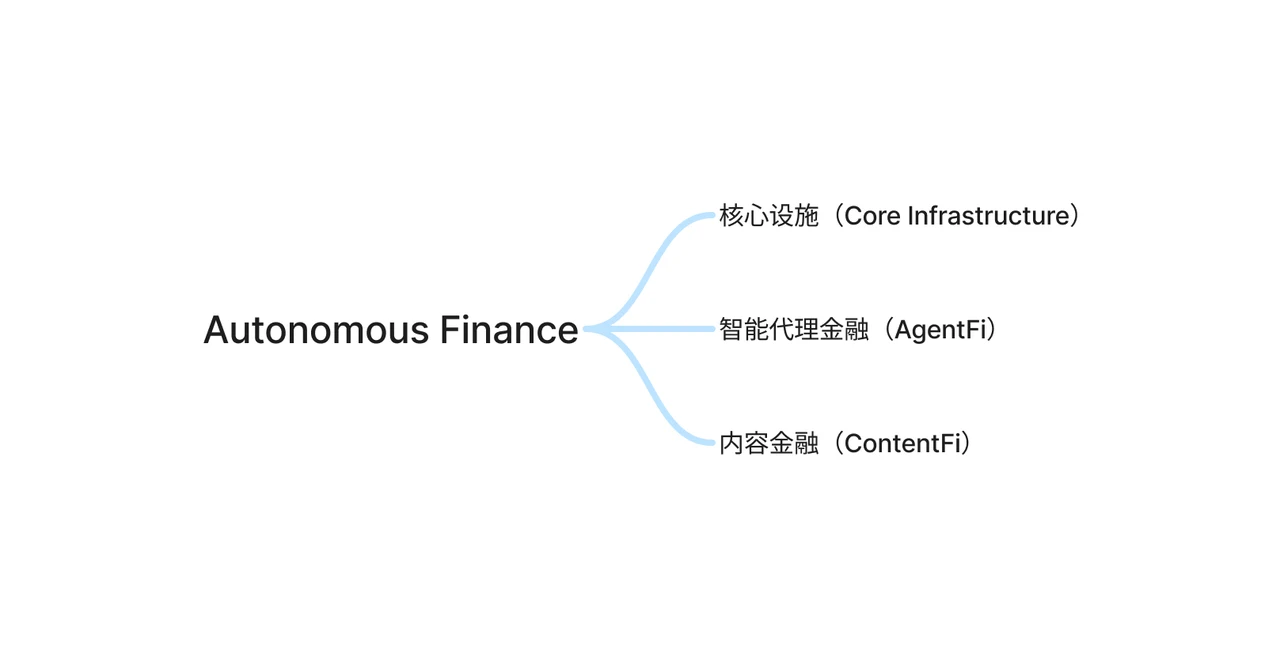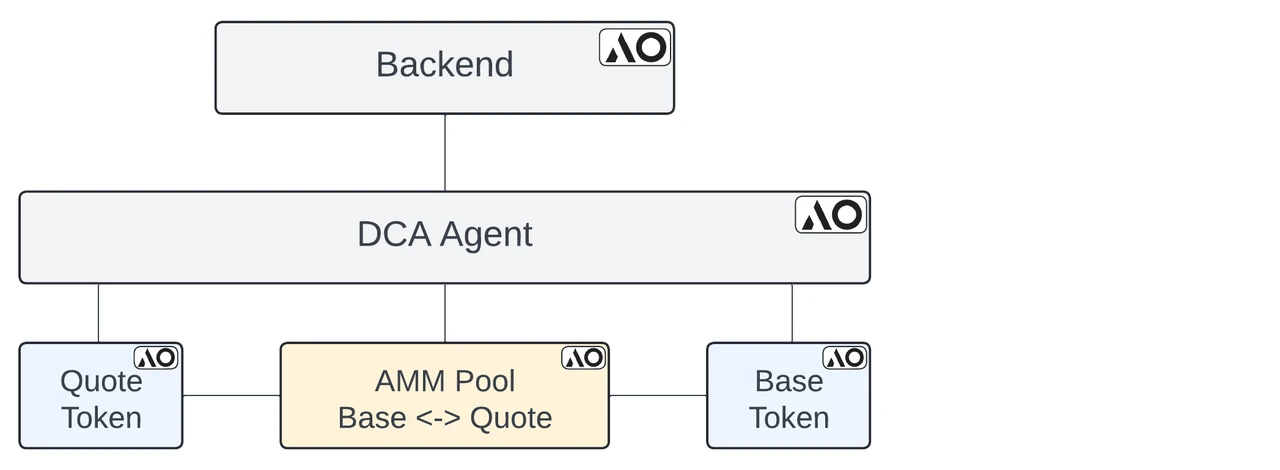Agent-Fi auf AO: Finanzparadigma mit Integration von KI-Agenten
Imagine that in the future world, AI agents and humans form a digital companion/symbiotic relationship. Autonomous agents can clarify intentions in conversations based on natural language requirements raised by users, automatically break down tasks and achieve expected results.
AO has established an asynchronous parallel network based on Actor. It does not reach consensus on the entire contract calculation process, but only reaches consensus on the transaction order. It optimistically defaults to a fixed transaction order and runs the same result in the virtual machine. This choice allows the AO network to be expanded on a large scale until it supports any type of calculation. The AR network is used as the consensus layer for the transaction order and the storage layer for the transaction result status.
Compared with other current mainstream blockchain projects, which are mostly single blockchains and only support smart contracts of native state machines from the bottom layer, AOs infrastructure compatibility can support more complex computing capabilities, including the operation of AI models.
After the recent WASM virtual machine update, AOs Compute Unit can now access 16 GB of memory, which means we can download and execute 16 GB models on AO. 16 GB is enough to run large language model calculations, such as the unquantized version of Llama 3 Falcon series and many other models.
At the same time, AO uses WeaveDrive, which allows users to access Arweave data in AO just like accessing a local hard disk, and is compatible with highly heterogeneous processes of different types of virtual machines interacting in a shared environment, which means that we have more data sources and combination possibilities. This also means that when building applications in the future, users will have more motivation to upload data to Arweave because the data can also be used in AO programs. When testing large language models running in the AO+AR system, the AO development team has uploaded approximately $1,000 worth of model data to the network, but this is just the beginning.
AOs system design makes it possible to implement smart contracts that integrate AI agents. By programming in AO, we create AI agents to make intelligent decisions in the market, and agents may fight against each other or represent humans against humans. When we look at the global financial system, about 83% of Nasdaqs transactions are executed by robots. The current quantitative trading is the predecessor of AI agent trading, and in the future, the process of designing and selecting machine learning models and executing automated trading will be more easily unboxed and automated by AI.
The development of DeFi in the past few years has made it possible to perform various financial operations on the chain without trusting centralized entities, such as lending, trading tokens or derivatives. But when we really talk about the market, it is not just the reliability of these operations. In fact, reliable execution of various operations is just the foundation. The core factor that determines whether a market is vibrant is still the flow of capital, and the people who decide to buy, sell, lend or participate in various financial games. At present, if you want to participate in cryptocurrency investment and don鈥檛 want to do all the research and participation yourself, you must find a reliable fund, trust them to manage your funds and delegate power to fund members to execute intelligent decisions. But with the development of AO applications, we may be able to expand the intelligent decision-making part of the market, filter information in the network, process data, combine strategies, integrate the wisdom of AI agents to make real-time decisions in the network, and create a very rich decentralized autonomous agent financial system.
There are already some projects that have begun to realize this vision. We will introduce Autonomous Finance (hereinafter referred to as AF), Dexi and Outcome. Among them, AFs achievements are the most impressive.
Autonomous Finance
AF focuses on researching and developing AI-based financial applications on AO. By building AI models and data-driven financial decisions on the AO chain, AF has attempted to put the intelligent decision-making layer on the chain. The main business consists of three parts: Core Infrastructure, AgentFi, and ContentFi.

Core facilities include decentralized exchanges (DEX), lending, derivatives, and synthetic asset protocols.
AgentFi mainly refers to the execution of trading strategies through composable semi-autonomous and fully autonomous agents. Unlike other autonomous agent frameworks that rely on off-chain programs for signal processing and logic processing, the autonomous agents provided by AF use on-chain data streams for self-learning and execute investment strategies on various liquidity pools and financial foundations within the AO ecosystem. These agents can run autonomously without the need for off-chain signals or human intervention.
Typical autonomous agents include:
-
Dollar Cost Averaging (DCA) Asset Management Agent
-
Self-Balancing Index Fund
-
Autonomous hedge funds with customized risk strategies
-
Revenue Aggregation Agent
-
On-chain prediction agent
-
High Frequency Trading Agent
The DCA agent is a basic agent that is often called when other more complex agents execute logic. Therefore, as a frequently used composable agent module, it has many customizable parameters for users to adjust according to their needs, such as triggering transactions within a specific price range, adjusting the length of fixed interval transactions, and weighted transactions based on asset prices (such as buying more when prices are lower), as well as data-driven stop-profit and profit reinvestment signals.
The DCA agent application is built around two key AO processes:
-
An agent process triggered by Cron (a time-based task management system, often used to trigger task execution at a scheduled time): mainly responsible for user-initiated and automatically scheduled DCA transactions, recording managed funds and updating the backend AO process in a timely manner
-
Backend AO process: manages proxy applications associated with the user and tracks and records historical transactions of each proxy
The following diagram illustrates the design architecture and interaction components of the DCA agent.

For users who use the front-end, the front-end of the DCA agent is built on DEXI, and users can set up the DCA agent by connecting the AO Connect wallet on the DEXI website. DEXI accesses information about available AMM pools and obtains the latest prices, the DCA agent is responsible for executing specific transaction logic, and the back-end AO process retrieves all agents related to the user.

Content Finance is a framework for attributing and monetizing data stored on the Arweave permaweb as composable assets for AO processes. AF is building applications that allow data contributors or content funds to contribute data such as historical and real-time market intelligence to the permaweb. This content will serve as on-chain signals for autonomous agents and machine learning. For example, autonomous agents will create new markets based on social media sentiment and historical data. Some examples:
-
Monetizing data signals
-
Content-driven financial agency
-
Subscription-based data recommendation agent
-
Influencers contribute data for autonomous financial strategies
-
Data contribution-related DAOs and content funds aggregate various data sources to provide dynamic on-chain signals
Currently, AF has launched two main products, namely AO Link and Data OS.
AO Link is a message browser for the AO network, providing similar functionality to block browsers in traditional blockchain systems. It includes message calculation capabilities, graphical visualization of message links (clear and easy to understand), real-time message streams (latest information), and linked message lists (easy to organize and navigate). Users can also view their token balances and message inboxes. This tool provides a professional and efficient way to interact with and analyze the structure and activity of the ao network.
Data OS is a ContentFI protocol developed on the AO Network that uses autonomous AI agents to acquire content and regenerate content derivatives. Through this innovative approach, DataOS not only enhances the relevance and accessibility of content, but also establishes a reward mechanism for content creators. Currently, we can view various data on the AO network in https://stats.dataos.so/ to observe network activity. Various data related to content are not displayed for the time being.
Dexi
Dexi is a crucial interactive interface for ordinary users to use agents in AO to participate in Agent Fi. It is also an application implemented by agents on the AO network, which can autonomously identify, collect and aggregate various financial data of various events in the AO network (equivalent to Dexscrenner on AO). These data cover asset prices, token exchanges, liquidity fluctuations, and token asset characteristics (such as smart contract details). Dexi mainly serves two types of users: end users who access the platform through web terminals and AO applications (understood as Bot/Agent) that interact with Dexi by sending messages to utilize the collected data. As a core infrastructure, the main service provided by Dexi is a data subscription service. Processes on the AO network can pay to subscribe to Dexis data stream and immediately receive alerts for updates such as price adjustments.
Outcome
Outcome is a prediction market built by the @puente_ai team, supported by @fwdresearch , @aoTheVentures Und @aoComputerClub . Outcome provides users with a platform to bet on various events. The current prediction topics in the market cover technology, memes, business, games, DeFi and AO. The project claims that in the future users can automatically bet on the prediction market by building autonomous agents based on real data and large language models.
AgentFi on AO provides us with a new perspective to explore the future of deploying AI models directly on the blockchain and using various AI agents to perform automated transactions. The limitations of traditional single blockchains are broken by the design of AO+AR with novel underlying innovations. We look forward to seeing more applications on AO and cases of implementing financial strategies in combination with AI agents.
siehe
https://www.theblockbeats.info/news/53865
https://permadao.com/permadao/AI-on-AO-AO-AI-224ba15c840a4309972fec5350d9ed90
https://www.communitylabs.com/blog/ao-in-ai-key-highlights?utm_source=Blogutm_medium=Xutm_campaign=AI+on+AOutm_id=Community+Labs
https://www.autonomous.finance/research/en-US
This article is sourced from the internet: Agent-Fi on AO: Financial paradigm integrating AI agents
Related: Inventory of the top Bitcoin ETF holding institutions: Who are the major holders?
Original author: Huo Huo The Bitcoin spot ETF was officially approved in early 2024, marking the first year in which traditional financial capital poured into the crypto world. As of June 1, global Bitcoin ETF holdings exceeded 1 million BTC. As of June 14, the total net asset value of Bitcoin spot ETFs reached approximately US$57.2 billion. Source: https://sosovalue.xyz The Bitcoin ETF 13 F (13 F report refers to the shareholding report of investment institutions with assets under management exceeding US$100 million in US stock companies) document submitted to the SEC as of May 15 shows that there are 929 institutions holding positions in all declared Bitcoin spot ETFs in the first quarter of 2024, which accounts for less than 20% of the total market. There are also 80.7% of…







